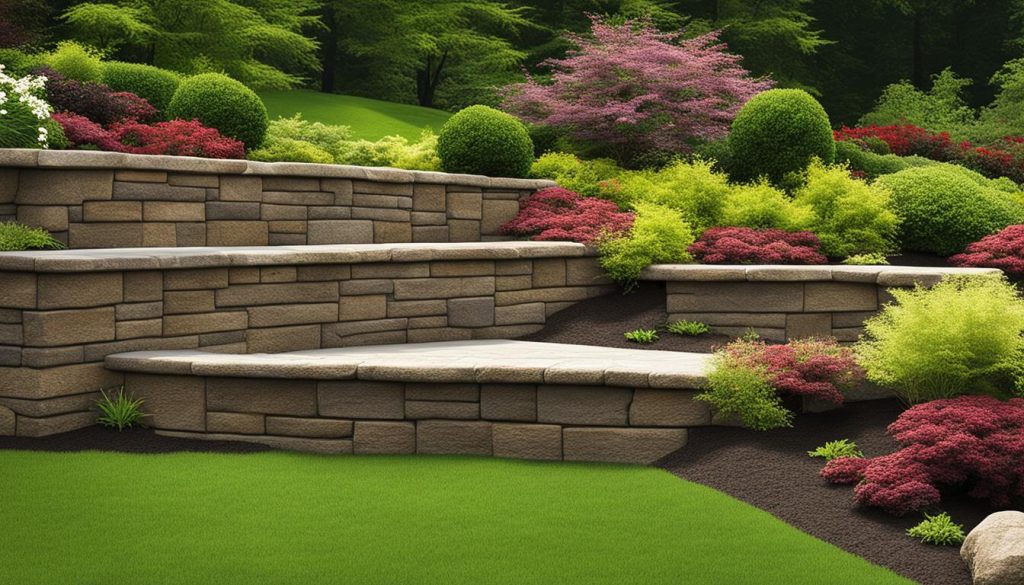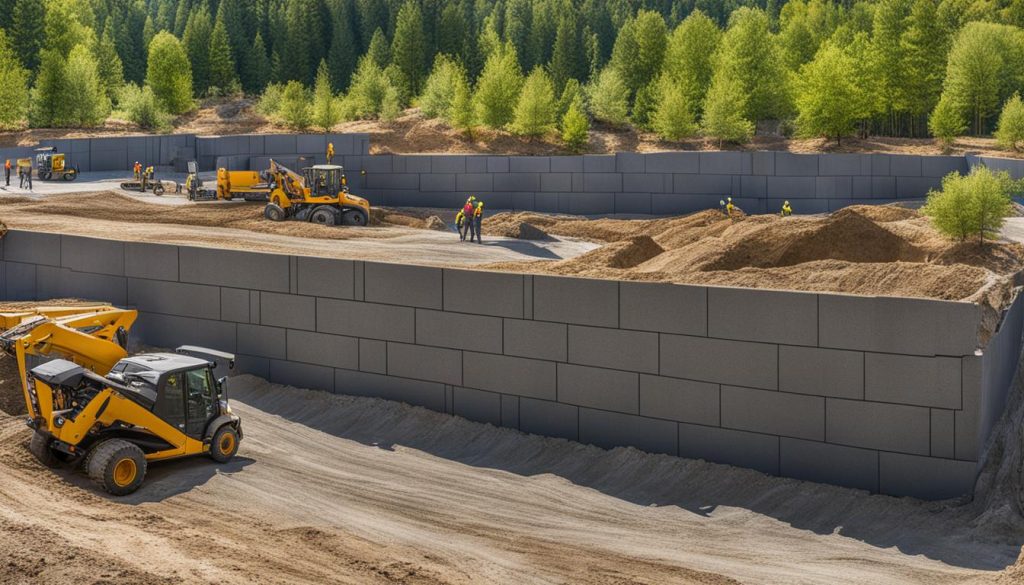Are you planning to build a retaining wall but concerned about the associated costs? We understand that budgeting for a retaining wall project can be overwhelming, but our team at Retaining Wall Repair is here to help. In this guide, we will provide you with all the necessary information to budget your project effectively. We aim to ensure that you have access to accurate and reliable information, allowing you to make informed decisions about your project without breaking the bank.
Our team has extensive experience in this field and understands the importance of cost-effective solutions for Canadians. Whether you need advice on selecting the right materials, estimating costs accurately, or navigating local regulations, we are here to help.
Key Takeaways
- Budgeting for a retaining wall project can be overwhelming, but it is essential to plan effectively to avoid unexpected expenses.
- Selecting the right materials and considering factors such as site accessibility and soil conditions can significantly impact the overall cost of your project.
- Understanding local regulations and obtaining necessary permits upfront will help you avoid potential fines and unexpected costs.
- We offer professional advice and services to help you navigate the process and achieve your desired outcome.
- By implementing cost-saving measures and evaluating long-term maintenance costs, you can achieve your project goals within your budget.
Factors Affecting Retaining Wall Costs
When it comes to retaining wall projects, several factors impact the overall cost. Being aware of these factors is crucial to budgeting your project. Let’s take a closer look at the key aspects that affect the cost of a retaining wall.
Size and Height of the Wall
The size and height of the wall are significant factors that influence the cost of a retaining wall project. Larger and taller walls require more materials, labour, and time, which can add up the costs. It is important to consider the height and size requirements of your project carefully and plan accordingly.
Materials Used
The type of materials used for your retaining wall project will also affect the cost. There are several materials to choose from, including concrete, wood, stone, and brick. Each material has its unique qualities and comes with different price tags. For example, concrete blocks are more affordable than natural stone, but the latter has better longevity. It is crucial to evaluate the cost-benefit analysis of each material before making a final decision.
Site Accessibility
The accessibility of your site is another essential consideration when it comes to retaining wall costs. If the site is challenging to access, then it can increase the labour costs. Factors such as steep slopes, rocky terrain, and narrow entrances can all add to the cost.
Soil Conditions
The soil conditions of your site can also impact the cost of your project. If there is poor soil stability, it might require additional excavation and the addition of reinforcements, which can increase the overall cost. It is important to have a soil analysis done ahead of time to understand what additional costs may arise.
Additional Features
Finally, additional features such as drainage systems, decorative elements, and lighting can add to the overall cost of a retaining wall project. While these features can enhance the overall design and functionality of your wall, they can also increase the budget.
Now that you understand the factors that influence the cost of a retaining wall project, you can budget accordingly. By planning for these costs upfront, you can ensure that your project stays within budget and meets your expectations.
Types of Retaining Walls and Their Costs
Retaining walls are a popular and functional addition to any landscape or outdoor environment. Different types of retaining walls are available, each with varying costs and benefits. Choosing the right type of retaining wall is important to ensure that it meets your functional and aesthetic requirements, while still being within your budget. In this section, we will explore the most common types of retaining walls and their costs.
Gravity Walls
Gravity walls are the most common type of retaining wall, and they rely on their weight and mass to hold back the soil. They can be constructed using a variety of materials, including concrete blocks, natural stone, and brick. Gravity walls are a cost-effective option and can be suitable for low to medium-height retaining walls.
Cantilever Walls
Cantilever walls are another popular type of retaining wall and are ideal for medium to high retaining walls. They are constructed using reinforced concrete and are anchored to a footing. Cantilever walls require less material than gravity walls, making them a more cost-effective option for taller walls.
The cost of cantilever walls varies depending on the height and length of the wall.
Segmental Retaining Walls
Segmental retaining walls are made of individual precast concrete blocks that interlock with each other, creating a strong and stable retaining wall. This type of retaining wall is versatile and can be used for both low and high retaining walls. Segmental retaining walls are easy to install and require minimal maintenance, making them a cost-effective option.
The cost of segmental retaining walls depends on the height and length of the wall, as well as the type of block used.

It is important to evaluate the costs and benefits of each type of retaining wall before making a decision. Your budget, as well as your functional and aesthetic requirements, should be taken into consideration. At Retaining Wall Repair, we can help you select the right type of retaining wall that meets your needs and budget.
Cost-Saving Tips for Material Choices
There are several ways to reduce costs when selecting materials for your retaining wall project:
- Reuse existing materials: If you have any leftover materials from other projects, such as stones or bricks, consider reusing them in your retaining wall project.
- Explore alternative designs: Depending on the materials used, alternative designs may require fewer materials, reducing upfront costs.
- Consider long-term maintenance expenses: Selecting a material that requires less maintenance and fewer repairs can save you money in the long run.
By being strategic with your material choices, you can save money while still achieving the desired outcome for your retaining wall project.
Hiring Professionals vs. DIY Retaining Walls
When it comes to your retaining wall project, you may be wondering whether to hire professionals or take the do-it-yourself approach. Both options have their pros and cons, and the decision ultimately depends on your budget, skill level, and the complexity of your project.
If you have experience with construction and feel confident in your abilities, taking on a DIY project can save you money in labour costs. However, it is important to consider the potential risks and pitfalls of this approach.
DIY Retaining Walls
Pros:
- Cost savings on labour
- Flexibility and control over the project
- Personal sense of accomplishment
Cons:
- Underestimating the complexity of the project
- Lack of equipment and tools
- Potential safety hazards
- Lesser quality of workmanship
It is crucial to consider these factors before starting your DIY retaining wall project. Be sure to research extensively beforehand, and seek advice from professionals to avoid any costly mistakes.
Hiring Professionals
Pros:
- Expertise and experience
- Access to equipment and tools
- Compliance with building codes and regulations
- Higher quality of workmanship
Cons:
- Higher labour costs
- Less flexibility and control over the project
While hiring professionals may cost more upfront, the benefits of their expertise and access to tools and equipment can save you money in the long run. Additionally, their compliance with building codes and regulations can ensure a higher quality of workmanship and a safer project overall.
At Retaining Wall Repair, we have a team of experienced professionals who can assist you with your project from planning to completion. Contact us at (647) 812-9837 to discuss your project requirements and receive personalized advice.

Permits and Regulations: Cost Considerations
When planning your retaining wall project, it is essential to consider the permits and regulations specific to your area. Depending on your location, you may need to obtain a building permit or adhere to local bylaws and regulations. These requirements aim to ensure that the retaining wall is safe, functional, and compliant with the set standards.
Applying for a permit can add to the overall cost of your project, but it is crucial for avoiding any legal issues or fines in the future. Permit fees can range from $100 to $1,000, depending on your location and the scope of your project. In addition, some cities may require inspections throughout the construction process, which can also add to the cost.
Depending on the specifics of your project, you may also need to comply with zoning regulations, setback requirements, or environmental considerations. These regulations aim to ensure that your retaining wall does not negatively impact surrounding properties or ecosystems. Before starting your project, research the local regulations and budget accordingly.
The Cost of Non-Compliance
It is essential to note that non-compliance with local regulations can lead to hefty fines or legal issues. These costs can far outweigh the initial cost of obtaining permits and complying with regulations. It is crucial to consult with a professional who has experience in navigating the local regulations to ensure that your project is compliant and meets all necessary requirements.
At Retaining Wall Repair, we understand the importance of complying with local regulations and obtaining the necessary permits. Our team can assist you throughout the permitting process, ensuring that your project is compliant and meets all necessary standards. Contact us at (647) 812-9837 to receive personalized advice and assistance in navigating the regulations.
Hidden Costs and Unexpected Expenses
When planning your retaining wall project, it is essential to consider potential hidden costs and unexpected expenses that may arise. These can significantly impact your budget and delay the completion of your project. We recommend taking the following factors into account when estimating the overall cost of your retaining wall:
- Excavation: Depending on the size and location of your retaining wall, excavation costs can add up quickly. Excavation may be required to accommodate the depth and width of the wall, and to ensure adequate drainage. Tip: Consider whether any existing structures or features on your property can be repurposed or incorporated into the design, reducing the need for excavation.
- Drainage systems: Proper drainage is essential for the structural integrity and longevity of your retaining wall. Depending on the site conditions, drainage systems can add significant costs to your project. Tip: Discuss drainage options with a professional to determine the most cost-effective solution for your site.
- Backfill: Backfill materials are used to fill the space behind the retaining wall and provide support. The cost of backfill can vary depending on the materials used and the amount required. Tip: Consider using recycled or locally sourced materials for backfill to reduce costs.
- Landscaping: Once your retaining wall is complete, landscaping may be required to restore the surrounding area. This can include planting, grading, and other site work. Tip: Plan your landscaping alongside your retaining wall project to avoid any unnecessary costs or delays.
It is important to note that these are just some of the potential hidden costs and unexpected expenses that may arise during your retaining wall project. By working with a professional and planning ahead, you can minimize the impact of these costs and stay within your budget.

Cost-Saving Tips and Strategies
At Retaining Wall Repair, we understand the importance of cost-effective solutions for Canadians. That’s why we’ve compiled a list of practical cost-saving tips and strategies for your retaining wall project. These suggestions can help you stay within budget while achieving the functionality and aesthetic appeal you desire.
Explore Economical Material Options
The choice of materials plays a significant role in determining the overall cost of your retaining wall. Consider using economical options such as concrete, which is relatively inexpensive and durable, or wood, which can be less expensive than other materials. Another option is using recycled or salvaged materials, which can add a unique touch to your wall while saving you money.
Reuse Existing Materials
If you’re renovating an existing retaining wall, consider reusing some of the materials to save on costs. By preserving materials that are still in good condition, you can reduce the amount of new material required for the project.
Design for Long-Term Maintenance
When planning your retaining wall, think about long-term maintenance costs and choose materials and designs that require minimal upkeep. For example, consider using plants as a natural way to prevent soil erosion instead of installing expensive drainage systems.
DIY Where Appropriate
While hiring professionals may be necessary for some aspects of your project, completing some of the work yourself can save you money. Consider doing the excavation or preparing the site yourself before hiring professionals to do the heavier lifting.
Compare Quotes and Negotiate Prices
Get quotes from several contractors and compare their prices before making a decision. Look for ways to negotiate prices, such as offering to pay upfront or in cash, or asking for a discount if you refer others to the contractor.
By implementing these cost-saving measures, you can stay within budget and achieve your desired outcome without compromising quality. At Retaining Wall Repair, we are committed to providing affordable solutions for Canadians.
Choosing Retaining Wall Repair for Your Project
When considering your retaining wall project, it is essential to choose a company that you can trust. At Retaining Wall Repair, we have a team of experienced professionals ready to assist you in every aspect of your project.
From the initial planning stages through to completion, we are here to guide you and provide you with peace of mind that your project is in good hands. Our team is equipped with the necessary expertise and equipment to tackle any project, no matter the size or complexity.
By choosing Retaining Wall Repair, you can expect personalized advice and attentive service that caters to your needs and preferences. Our team understands that no two projects are the same, and we take the time to listen to your requirements and work with you to devise a plan that aligns with your budget and expectations.
Our commitment to quality and customer satisfaction is reflected in our previous work, which showcases our attention to detail and craftsmanship. We take pride in ensuring that our clients are happy with the final result and that their retaining wall project meets their desired outcome.
Contact us today at (647) 812-9837 to discuss your retaining wall project and receive a free quote. We look forward to working with you.
FAQ
How much does a retaining wall cost?
The cost of a retaining wall can vary depending on various factors, such as the size, height, and materials used. It’s best to contact us for a personalized quote based on your specific project requirements.
What factors can affect the cost of a retaining wall?
Several factors can influence the cost of a retaining wall, including the size and height of the wall, the materials used, site accessibility, soil conditions, and any additional features you may want to include.
What are the different types of retaining walls and their costs?
There are various types of retaining walls, including gravity walls, cantilever walls, and segmental retaining walls. The costs associated with each type can vary depending on their functionalities, aesthetic options, and materials used.
How do material choices impact the cost of a retaining wall?
The choice of materials for a retaining wall can significantly affect the overall cost. Different materials, such as concrete, wood, stone, and brick, have varying installation costs, long-term maintenance expenses, and durability considerations.
Should I hire professionals or opt for a DIY approach?
Deciding whether to hire professionals or undertake a DIY approach depends on your budget and skill level. While DIY can potentially save you money, professionals have the expertise and equipment to ensure a successful and long-lasting retaining wall.
What are the cost considerations related to permits and regulations?
Before starting your retaining wall project, it’s important to consider the costs associated with obtaining permits and complying with local building codes. These costs can vary depending on your area and the specific requirements.
Are there any hidden costs or unexpected expenses to consider?
Yes, when budgeting for your retaining wall project, it’s crucial to account for potential hidden costs, such as excavation, drainage systems, backfill, and landscaping. Being aware of these expenses upfront will help you plan your budget more accurately.
Are there any cost-saving tips for retaining wall projects?
Absolutely! We can provide you with cost-saving tips and strategies, such as sourcing economical materials, reusing existing materials, exploring alternative designs, and considering long-term maintenance expenses. Implementing these measures can help you stay within budget without compromising quality.
Why should I choose Retaining Wall Repair for my project?
At Retaining Wall Repair, we pride ourselves on providing reliable and professional services for all your retaining wall needs. Our experienced team can assist you throughout your project, offering personalized advice and delivering high-quality results. Contact us at (647) 812-9837 or visit our website for more information and examples of our previous work.

